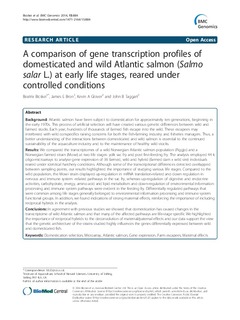| dc.contributor.author | Bicskei, Beatrix | |
| dc.contributor.author | Bron, James E. | |
| dc.contributor.author | Glover, Kevin A. | |
| dc.contributor.author | Taggart, John B. | |
| dc.date.accessioned | 2014-10-30T12:35:37Z | |
| dc.date.available | 2014-10-30T12:35:37Z | |
| dc.date.issued | 2014-10-09 | |
| dc.identifier.citation | Bicskei B, Bron J, Glover K, Taggart J: A comparison of gene transcription profiles of domesticated and wild Atlantic salmon (Salmo salar L.) at early life stages, reared under controlled conditions. BMC Genomics 2014, 15(1):884. DOI:10.1186/1471-2164-15-884 | nb_NO |
| dc.identifier.issn | 1471-2164 | |
| dc.identifier.uri | http://hdl.handle.net/11250/225120 | |
| dc.description.abstract | Background
Atlantic salmon have been subject to domestication for approximately ten generations, beginning in the early 1970s. This process of artificial selection will have created various genetic differences between wild and farmed stocks. Each year, hundreds of thousands of farmed fish escape into the wild. These escapees may interbreed with wild conspecifics raising concerns for both the fish-farming industry and fisheries managers. Thus, a better understanding of the interactions between domesticated and wild salmon is essential to the continued sustainability of the aquaculture industry and to the maintenance of healthy wild stocks.
Results
We compared the transcriptomes of a wild Norwegian Atlantic salmon population (Figgjo) and a Norwegian farmed strain (Mowi) at two life stages: yolk sac fry and post first-feeding fry. The analysis employed 44 k oligo-microarrays to analyse gene expression of 36 farmed, wild and hybrid (farmed dam x wild sire) individuals reared under identical hatchery conditions. Although some of the transcriptional differences detected overlapped between sampling points, our results highlighted the importance of studying various life stages. Compared to the wild population, the Mowi strain displayed up-regulation in mRNA translation-related and down regulation in nervous and immune system -related pathways in the sac fry, whereas up-regulation of digestive and endocrine activities, carbohydrate, energy, amino acid and lipid metabolism and down-regulation of environmental information processing and immune system pathways were evident in the feeding fry. Differentially regulated pathways that were common among life stages generally belonged to environmental information processing and immune system functional groups. In addition, we found indications of strong maternal effects, reinforcing the importance of including reciprocal hybrids in the analysis.
Conclusions
In agreement with previous studies we showed that domestication has caused changes in the transcriptome of wild Atlantic salmon and that many of the affected pathways are life-stage specific We highlighted the importance of reciprocal hybrids to the deconvolution of maternal/paternal effects and our data support the view that the genetic architecture of the strains studied highly influences the genes differentially expressed between wild and domesticated fish. | nb_NO |
| dc.language.iso | eng | nb_NO |
| dc.publisher | BioMed Central | nb_NO |
| dc.rights | Navngivelse 3.0 Norge | * |
| dc.rights.uri | http://creativecommons.org/licenses/by/3.0/no/ | * |
| dc.title | A comparison of gene transcription profiles of domesticated and wild Atlantic salmon (Salmo salar L.) at early life stages, reared under controlled conditions | nb_NO |
| dc.type | Journal article | nb_NO |
| dc.type | Peer reviewed | nb_NO |
| dc.subject.nsi | VDP::Agriculture and fishery disciplines: 900::Fisheries science: 920::Fish health: 923 | nb_NO |
| dc.source.pagenumber | 14 p. | nb_NO |
| dc.source.volume | 15 | nb_NO |
| dc.source.journal | BMC Genomics | nb_NO |
| dc.source.issue | 1 | nb_NO |
| dc.identifier.doi | 10.1186/1471-2164-15-884 | |

